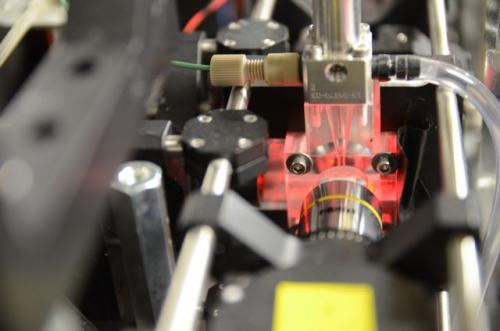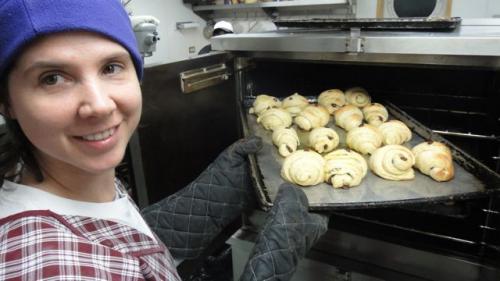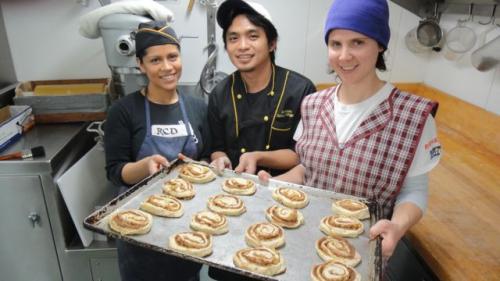Science is all done on the cruise. People have finished running their samples through the analysis and everyone is busy packing their labs. Seas are still very calm, although there is a bit more swell than in past days. Still very unantarctic
What do phytoplankton have in common with croissants? Aboard the Palmer, Emily Peacock is the right answer. Emily is in charge of creating a 'photo album' of as many organisms from the phytoplankton as possible. She works at the Woods Hole Oceanographic Institution (WHOI), in Woods Hole, Massachusetts. Let us find out how she gets the photographs she needs for the album, and what does all this have to do with croissants.

PhytoplanktonSmall or microscopic aquatic plants that float or drift in fresh or salt water. are single-celled plants that are found in the upper layers of the ocean where the sunlight can reach. They obtain their energy from the sun, like land based plants do, through a process known as photosynthesis. They use the solar energy to combine carbon dioxide (CO2) and water to form oxygen, which you and I breath, and carbohydrates (molecules with oxygen, carbon and hydrogen), which is what plants are mostly made of. They absorb the solar energy with particular pigments, the most common being the green chlorophyll. Different species have adapted to live in different parts of the oceans. Some scientists are interested on creating a catalog with all the species and where they are found. They also want to know the percentage composition of species in each community. Emily is part of a group lead by Dr. Samuel Laney, WHOI.
Emily collects water samples for obtaining the organisms in two ways. She samples every now and then from the main rosette, but only from the surface bottles (down to ~100 meters). There is no need to collect samples deeper than 100 m since there is very little sunlight at those depths, and therefore, very few phytoplankton. When Emily is not collecting samples from the bottles, water from just below the ship is taken through a hose by a pump to her lab, for a photo event.
Emily's instrument is quite a camera setup, as you can imagine given the size of the organisms she is photographing. The phytoplankton she is photographing range between 5 µm and 100 µm (1 micrometer (µm) = 0.000001 meter). The instrument samples 5 ml of seawater at a time and sends it slowly through a narrow glass passage called a flow-cell. Only one organism can go through the narrow passage at a time.

A laser beam shines on the thinnest part of the flow cell, which makes the chlorophyll in each cell of plankton fluoresce. A sensor detects the fluorescence of the chlorophyll and triggers the camera. Pretty ingenious! That way, the camera only takes a picture when there is an organism from the phytoplankton in the flow-cell. Not quite, zooplankton, animals that float in the upper layer of the ocean and rely on currents to move horizontally, can also be photographed because they have chlorophyl form the phitoplankton that they eat.
After the pictures are collected, the data analysis can begin. The pictures are first sorted with an auto-classification system, sort of like facial recognition like on a CSI show. Then, Emily uses additional software to manually correct the results of the auto-classifier. In the end, the auto and manual classification provide the results for the phytoplankton census.
Some phytoplankton you may find in Antartica (some of the ones Emily has found):

Did you see any croissants in the process of photographing phytoplankton? Neither did I. It turns out that Emily is also an accomplished baker, and on nights that not much is happening in the labs, she finds her way all the way to the galley and convinces Ale to let her bake some yummy croissants and other pastries. Here she is placing a tray in the oven.

I wake up after one of those nights once they have baked and eaten some of the pastries to find delicious treats awaiting for me and the rest of the day watch. They are irresistible!
Here is a picture of Emily, Ale and Jermaine, who also helps with the baking. My thanks to all three of them!

Fitoplancton y cuernitos
¿Qué tienen en común el fitoplancton y los cuernitos? Abordo del Palmer, la respuesta es Emily Peacock. Emily está encargada de generar un 'album de fotos' del fitoplancton en estas aguas. Ella trabaja en el Woods Hole Oceanographic Institution (WHOI), en Woods Hole, Massachusetts. Veamos como trabaja en las fotos que necesita para el abum, y que tiene que ver todo esto con los cuernitos.

Fitoplancton son plantas de una sola célula que se encuentran en las capas superiores del océano donde llega la luz solar. El fitoplancton, al igual que las plantas terrestres, obtiene su energía del sol mediante el proceso conocido como fotosíntesis. Utilizan esta energía para cominar el dióxido de carbono (CO2) y agua para producir oxígeno, que tu y yo respiramos, y carbohidratos (moléculas de oxígeno, carbono e hidrógeno), que de lo que las plantas están hechas principalmente. Absorben la energía solar mediante pigmentos, el más común es la clorofila. Las diferentes especies se han adaptado a vivir en diferentes partes del mar. Algunos científicos están interesados en generar un censo para saber dónde vive cada especie y la composición porcentual de las comunidades de fitoplancton en términos de las especies. Emily es parte del grupo del Dr. Sam Laney, de WHOI.
Emily colecta las muestras de agua para encontrar el fitoplancton de dos formas. Obtiene sus muestras de vez en cuando de las botellas de la roseta principal, pero tan sólo de las botellas superficiales (hasta cerce de 100 m). No tiene caso obtener muestras de aguas más profundas ya que poca luz llega a esas profundidades y por lo tanto hay poco fitoplancton. Cuando Emily no muestrea dela roseta, una manguera justo debajo del casco del buque succiona agua y la manda al laboratorio de Emily para una sesión fotográfica.
EL instrumento de Emily es una sistema fotográfico bastante sofisticado, como debe ser cuando se intenta retratar organismos que midel entre 5 micrómetros y 100 micrómetros (1 micrómetro (µm) = 0.000001 m). El instrumento usa 5 ml de agua de mar que pasan por un conducto muy pequeño a traves de un rectángulo de vidrio llamado 'celda de flujo'. Un solo organismo puede pasar por el pasaje más angosto.

Un laser ilumina el conducto de la celda de flujo en su parte más angosta, lo que hace que la clorofila fluoresca. Un sensor detecta la fluorescencia de la clorofila y dispara el obturador de la cámara. ¡Bastante ingenioso! De esta forma la cámara solo toma fotos cuando hay un organismo del fitoplancton en la celda de flujo. De hecho el sistema también retrata el zooplancton, pequeños animales que flotan y que dependen de las corrientes oceánicas para desplazarse horizontalmente, ya que estos tienen en su interior la clorofila del fitoplancton que se han comido.
El análisis de imágenes comienza ya que se han tomado las fotografías. Las fotos se organizan en diferentes categorías mediante un programa de computadora como los programas de reconocimiento facial que se muestran en los programas de televisión como CSI. Emily usa otro programa para corregir manualmente los resultados del clasificador automático. Al final, los dos sistemas de clasificación producen el censo.
Aquí una foto con algunos de los organismos que se han encontrado.

¿Viste los cuernitos en el proceso que describí? Yo tampoco. Resulta que Emily también es una buena panadera, y en las noches en las que no hay mucho que hacer en el laboratorio, se enfila hacia la cocina y convence a Ale que le deje hornear pan dulce. Aquí la vemos con una charola de pan.

Yo despierto tras una de esas noches para encontrar el delicioso pan que el turno nocturno no se ha comido. Irresistible.
Aquí una foto de Emily con Ale y Jermain, los panaderos de abordo. Muchas gracias a los tres.



Comments